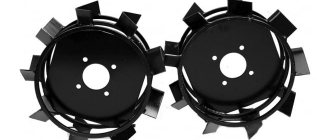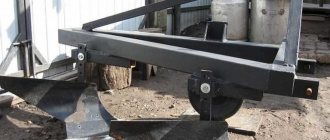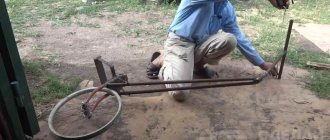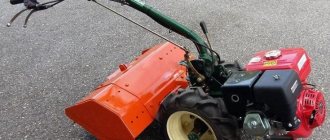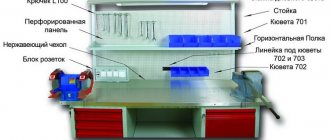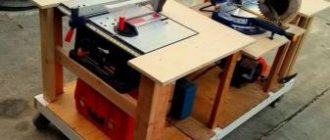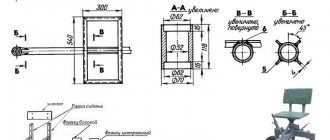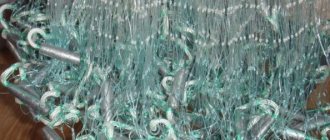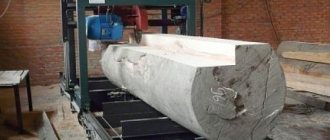With the help of a walk-behind tractor, you can do a lot of different work if, in addition to the unit, you have the appropriate attachments. The main task of any walk-behind tractor is soil cultivation: plowing, hilling, possibly planting and digging up potatoes with a certain canopy. Plowing requires grousers for the cultivator. These are reliable assistants for every unit owner, and you can make lugs for a walk-behind tractor with your own hands within a few hours. Grousers are a fairly common attachment that allows you to increase the weight of the equipment and provide better traction of the walk-behind tractor with the soil.
general information
- By design, these devices are wheels with spikes. Today there are many different device transformations, and you should choose them wisely. To a large extent, the quality of work is determined by the weight of the unit. The most functional awnings can only be hung on heavy walk-behind tractors or medium-weight units. If the unit is of high quality and does not give the desired result, you need to additionally purchase wheels with lugs for it.
- Standard devices are metal wheels with spikes that dig into the ground and engage the walk-behind tractor with it. To make devices yourself, you will need to know their structure, which drawings and diagrams will greatly help with. You will need to determine the diameter of the canopy, select the material of manufacture, and, of course, select the necessary tools. The first thing you need is a welding machine and an angle grinder.
- First of all, we decide on the size of the devices. Their height and width depend on the tasks for which the hooks are mounted on the walk-behind tractor. You also need to take into account the requirements for the weight of the devices, because the wheels are put on with them to improve the traction of the walk-behind tractor with the ground. This requires wheels of considerable weight, which a walk-behind tractor may lack. The minimum weight of wheels is 20 kg. If necessary, weights are hung on the soil hooks. This is necessary to achieve better results, or is used when the weight does not reach the norm.
Making your own hooks
- The easiest way, perhaps, is to make lugs from unnecessary rims from car wheels. Using a welding machine, an axle shaft is attached to the disks, onto which bearings are then placed. Square metal plates are welded to car rims so that they touch the edges of the rim.
- Then the plates are bolted to the rim. Next, teeth are made - steel hooks that will go into the ground. For this purpose, you will need a steel plate, for example, a corner, which is cut into pieces by a grinder, and from these parts the same teeth are welded, which are made in the factory. The resulting hooks are placed on the wheel rim 15 cm from each other.
- Homemade hooks can be made from an old gas cylinder. Two disks are cut out of it for wheel rims, 5-7 cm wide and 30 cm high. Next, the same operations are performed as with car disks.
- To improve the performance of wheels with hooks, you can weld another tooth on top of each hook and lengthen the teeth to 60 cm. An axle is made: a metal plate is attached to one rim on which this axle will be placed.
- The lugs can be made from any round-shaped blank. The main thing is to choose the right width and diameter of the future wheel with hooks. The dimensions of the wheel are determined functionally, that is, based on the purpose of use on the walk-behind tractor.
For "Neva"
Each brand of walk-behind tractor has attachment options that are more suitable to its design than others. It is better, of course, to purchase a universal walk-behind tractor, for which almost all awnings are suitable. Wheels with lugs Ø 340×110 are produced for the Neva.
In design, these lugs are slightly larger than the homemade ones we described. You must follow the instructions above, but choose rims of other sizes. The height of the wheel to hook the Neva should be 340 mm, the width of the homemade device should be 110 mm.
For "Centaur"
The lugs for walk-behind tractors of this brand differ only in size. The dimensions that needed to be taken into account when converting old wheels into lugs for the Neva were described above. The same scheme is used for the manufacture of wheels with large hooks. The wheel height is selected 450 mm. The wheel width should be 110 mm, as for the Neva. Such hooks are suitable for the Centaur 2060 and 2090 walk-behind tractor and units with similar parameters. The factory version will cost about $30.
For "Bison"
The walk-behind tractor of this brand is a heavy professional equipment, and it can be equipped with the best available attachments. In order for the “Bison” to penetrate the ground perfectly, it needs lugs. The standard devices that fit it have a 200 mm tire and a height of 700 mm. Wheels of this width are only suitable for heavy walk-behind tractors and, in addition to the Zubr JRQ78 and 79, are also suitable for the Centaur 1070D, Aurora 101 and Aurora 81, Zirka LX1080D and 1090. In the factory version, the distance between the hooks is 14.5 cm. The wheel hub has a diameter of 60 mm. They are attached to the walk-behind tractor using an additional hub.
Why do you need do-it-yourself lugs for a walk-behind tractor?
Of course, to a large extent the quality of work depends on the weight of the unit. You can hang all the most functional awnings only on heavy walk-behind tractors and medium-heavy devices. But the heaviness and professionalism of the walk-behind tractor is not everything. If you have a seemingly cool unit, but don’t get the desired results, you should purchase wheels with lugs for the walk-behind tractor. You can buy, or you can make lugs for a walk-behind tractor with your own hands. It all depends on the size of the wallet, desire and directness of hands.
Standard lugs for walk-behind tractors are metal wheels with spikes that bite into the ground and connect the walk-behind tractor with the soil. In order to make lugs for a walk-behind tractor with your own hands, you will need knowledge of the design of lugs (the drawing and diagram will seriously make this task easier for you), determine the diameter of the canopy, select the material for converting into lugs for a walk-behind tractor, and, of course, tools for working with the original material. Essentially, it's a grinder and a welding machine.
Before making lugs, decide on their size. The height and width of the lugs depends on the task for which you place them on the walk-behind tractor. Later we will discuss what sizes the factory lugs that you can buy in the store can be.
And also the requirements for the severity of the lugs. After all, you put on wheels with lugs in order to improve the traction of the walk-behind tractor with the ground, and for this you need a good weight of the wheels, which the walk-behind tractor itself may not have enough. The minimum weight of wheels is 20 kg. You can also add weights to the lugs if you want to get a better result or the weight of the wheels is not up to standard.
Lugs for walk-behind tractors: what to look for?
The main factor influencing the choice of a universal object is size. If a person wants to purchase lugs for a specific unit model, he should familiarize himself with the wishes of the manufacturer and follow them.
Since the Neva and Neva MB walk-behind tractors are especially popular among farmers and agronomists, we should use their example to outline the features of universal lug wheels. For the products of these manufacturers, options with a diameter of 43 cm are suitable, because they are laid in the soil to a depth of 15 cm. These dimensions will ensure maximum traction with the ground and trouble-free movement.
For absolutely all Salyut walk-behind tractors, wheels with a diameter of 50 cm will be relevant, the spikes of which sink into the ground at least 20 cm. Naturally, each manufacturer has its own requirements for lugs, so you should carefully study the operating instructions for the walk-behind tractor you have and not ignore the wishes of the manufacturers.
An important point: heavy-duty equipment does not need such additions, because its weight is already a guarantee of stability on almost any ground.
Description and sizes of hooks
Heavy walk-behind tractors are most suitable for working on heavy soils and, accordingly, hooks with a larger width and height are more suitable for coupling the unit with virgin soil or very neglected soil. For highly complex work, weights are attached to the wheels.
The dimensions of the hooks vary between 310-700mm in height and 100-200mm in width. The Salyut walk-behind tractor is suitable for lugs of 500×100 mm and 500×200 mm. The latter are functional together with the plow. You can buy the same size with a sand-filled weighting agent so that the mounted plow plows the soil deeper. If you have 500x200 hooks, you can make the weight yourself. Wheels with hooks measuring 700x130 mm are put on the walk-behind tractor to work with hillers, flat cutters and potato diggers.
Lugs for "Zubr"
In addition to those described above, the heavy Zubr JRQ78 and 79 walk-behind tractor can easily accommodate 700×100 mm hooks. Their width is smaller, and, in addition to heavy ones, they can be used with medium-heavy walk-behind tractors.
The hooks for the Zubr will fit the Neva. Hooks of this size are in great demand , precisely due to better compatibility. Wheels 700×200 can only be put on heavy units, and they are intended for processing virgin soil. Wheels 700×100 are suitable for the average needs of a farmer; they can be safely stored and mounted on another walk-behind tractor when the existing one becomes outdated, even one with weaker power. 700x100 lugs will cost about $70.
How to choose?
When choosing a suitable model, first of all you should pay attention to the brand of the walk-behind tractor. For the Neva and Neva MB model range, variations with a 43-centimeter diameter, the depth of immersion of the spikes into the ground is 15 cm, are excellent. For Salyut brand walk-behind tractors, lugs with a half-meter diameter are needed, in which the depth of immersion in the soil will be at least 20 cm For "Bison" you need tall products - 70 cm in diameter.
Only heavy walk-behind tractors do not require lugs; their mass guarantees them stable movement on almost any surface. But if you decide to improve the maneuverability of your heavy model of walk-behind tractor (weighing more than 0.2 tons), choose wide lug devices - 70 cm in diameter.
Please pay attention to one important point - there must be no contact between the surface of this type of attachment and the body of the unit.
The choice of a suitable lug model also depends on the type of soil and the nature of the outer side of the products. Their surface can be designed in the form of spikes or arrows. When purchasing products, keep in mind that the low height of the spikes is not suitable for wet and loose soils - they are ineffective and are easily clogged with soil. Arrow-shaped hooks are the most popular and are considered universal.
When purchasing additional equipment for your unit, first consider options from the same manufacturer.
Pay attention to the cost - it depends on the manufacturer and modification.
Do not forget that light walk-behind tractors also require weighting structures, otherwise on difficult soils you will have to deal with the unit slipping.
The simplest holds
For production you need the following:
- Iron sheet 4-5mm wide for wheel rims.
- Iron sheet 6-8mm wide for hooks.
- Apparatus.
- Bulgarian.
- Drilling machine or powerful drill.
Two similar disks are cut from a narrower sheet. A hole is made in the center for the hub and mounting on the wheel studs. Saw-tooth projections 10 cm deep are cut along the outer edge. Triangular hooks with cut corners are cut out of a thick sheet. They are welded strictly perpendicular to the sawtooth cuts.
Despite their unprepossessing appearance, homemade hooks made using this method have the formidable power of gaming slots - they are heavy enough to provide a strong grip even on an otherwise loose surface. It makes no sense to talk about moving on a dirt road; such wheels are only intended for work in the field.
Another economical option is to make it from a steel circle Ø15mm. You will like the used steering wheel from the valve on the main gas pipeline, if there is a pair. The hooks are welded to the outer rim, and the hub is attached to the center.
For the next design you will need car wheels. This production option for a homemade walk-behind tractor is not bad. When designing, standard wheel hubs from a car are provided, and the entire set of 4 wheel disks is purchased. Tires are installed on one pair, and the second is needed for heavy ground.
An iron corner of 50-60 mm is taken and cut into pieces that are slightly wider than the disks. In the center of one side, a triangular sector of 60° is cut out with a grinder.
Do-it-yourself lug lugs for a walk-behind tractor.
The corner is heated with a gas burner and bent along the cutout. There is an option to tack the joint a little by welding to provide additional hardness. The found blanks are welded to the outer side of the disk, and an equal distance is maintained.
The assembly is repeated on the second disk, do not forget about the same distance between the corners. At the moment, you can quickly replace rubber wheels with steel hooks, and there will be no problems with the seat, because the wheels are identical.
The design of the discs on the wheels is lightweight for you. For this purpose, the horizontal part (rim) is cut off and steel plates are welded on. This option is suitable for frequent wheel changes on a type 1 hub. Discs are selected accordingly.
Sources:
https://www.gardenshop.ua/gruntozatsepy-svoimi-rukami-dlya-motobloka.html https://stroy-podskazka.ru/navesnoe-oborudovanie/gruntozacepy-svoimi-rukami/ https://metallvsegda.ru/stanki -i-oborudovanie/kak-izgotovit-gruntozatsepi-dlya-motobloka-svoimi-rukami.html
Dimensions of lugs for walk-behind tractors
The heavier the equipment, the better and more practical it is. High-quality, heavy-duty equipment allows you to work even on hard ground, which a lightweight mini tractor can handle with considerable difficulty. Heavy mini tractors require the same large lugs. In general, the scale of lugs depends on the size of the walk-behind tractor. The height of the equipment can be from 310 to 700 mm, and the width from 100 to 200 mm. The dimensions of the lug must be selected based on the modification of the unit. The scope of certain models is presented below.
Neva
You need to purchase walk-behind tractors that can adapt to each attachment, or, more simply, universal ones. However, what to do when the farm already has a mini tractor from the Neva company, which is by no means considered universal. The wheels of this device for working with soil have scales from 340-360 to 90-110 mm, and on the Neva MB they are 480-500 x 190-200. When producing a homemade hook for the Neva, you need to take into account that the height should be 340-360 mm and the width 90-110.
Firework
In this case, you can assemble the lug according to the same scheme as Neva. The sizes of Ugra MB or Salyut wheels are from 480-500 to 190-200 mm. Thus, the lug must be made 48-50 cm in length and 19-20 cm in width, the same dimensions are made on the Oka MB series.
Centaur
The wheels on the Centaur are similar to those on the Neva walk-behind tractors. Their difference is that the Centaur’s wheel length is eleven cm longer than that of the Neva. When producing a lug, it is necessary to make it 450 mm long and 110 mm wide, the same dimensions for the Zirka, Vityaz, Aurora, Bulat models. Such a hook will fit the Centaur 2060 and 2090, as well as various units with similar dimensions. In a shopping center, the cost of similar lugs is 2000-2500 rubles.
MTZ
Despite the fact that MTZ walk-behind tractors are made in Belarus, the cost of such units is quite considerable. The approximate price of a lug for MTZ is from 4,000 to 5,000 rubles. The fact is that the wheels of these walk-behind tractors are quite large, their size is 540-600x130-170 mm. To make a lug for a MTZ walk-behind tractor with your own hands, you need to follow the instructions described earlier and make the values corresponding to these wheels, that is, 540-600x130-170. The same dimensions are used for Agro models.
Cayman Wario
The French company Cayman produces excellent walk-behind tractors, the price of which can exceed 60-70 thousand rubles. Also, the additional equipment on them is by no means low in cost. The price of a lug for the Cayman Vario is from 5 to 7 thousand rubles. Their size is 460x160 mm, there are also extended ones 600x130 mm. The same sizes are used on the Caiman Elite, Compact, Eco, Promo, Primo, Q Junior series. You can also make a lug yourself, although a person who allows himself to buy such a walk-behind tractor will be able to purchase any equipment for it from the store
Oka
Oka walk-behind tractors are domestically produced and a fairly common product in the Russian Federation. Farmers and hobbyists are increasingly trying to make additional equipment specifically for such units. When making a lug on Oka, the length should be 450 and the width 130 millimeters. The manufacturing scheme is the same as for other walk-behind tractors - everything is extremely simple. In the store the price of such equipment is approximately 2500 rubles. But why spend money when you can do everything at home.
You may be interested in articles about trailed harrows for walk-behind tractors and rotary plows.
Bison
The Bison is a massive, impeccable mini tractor that can cope with numerous tasks on the farm. It comes with only the best suspended special equipment. The size of its wheels is 700x200 mm, the lug dimensions are similar. In addition, certain modifications of the bison accept lugs measuring 700x100 mm. For this reason, it is possible to make lugs of each of these sizes. However, it is recommended to produce 700x100, as this is more suitable for household needs. Dimensions 700x200 mm are mainly suitable for working in virgin soil. The cost of the Zubr lug in shopping centers ranges from 20 to 50 thousand rubles.
Cascade
Another domestic manufacturer of special equipment. Motoblocks of this company are also very famous. For this reason, it will be useful for many to find out what diameter the lug should be for such a device. Height - 460-680 mm, width - one hundred to one hundred and ninety-five millimeters.
The simplest lugs for a walk-behind tractor with your own hands
For production you will need:
- iron sheet 4-5 mm wide for wheel rims;
- iron sheet 6-8 mm wide for hooks;
- Bulgarian;
- apparatus;
- drill press or powerful drill.
From a narrower sheet we cut out two similar disks. We make a hole in the center for the hub to attach the wheel to the studs. We cut sawtooth projections along the outer edge, 10 cm deep.
From a thick sheet we cut out triangular shaped hooks with cut corners. We weld them strictly perpendicular to the sawtooth cutouts. That's it, the design is ready for use.
Despite the unprepossessing design, homemade lugs for walk-behind tractors made in this way have the same principle as gaming slots. They are heavy enough to provide strong grip even on otherwise loose, muddy surfaces.
Of course, moving on a dirt road should be out of the question. Such wheels are intended only for work in the field.
An additional economical option is made from a steel circle with a diameter of 15 mm. They use the steering wheel from the valve on the main gas pipeline, if they can get a pair somewhere. Hooks are welded onto the outer rim, and a suitable hub is attached to the center.
The following design is made from auto wheels. This is the best option for a homemade walk-behind tractor. When designing, you provide standard wheel hubs from the car, and purchase a complete set of 4 wheel rims. You install tires on one pair, and the next reason will be for heavy soil.
We take an ordinary iron corner 50-60 mm and cut it into pieces slightly wider than your disks. In the center of one side we cut out a triangular sector of 60° with a grinder.
We heat the corner with a gas burner and bend it along the cutout. The joint can be slightly tacked by welding for additional rigidity. We weld the acquired blanks onto the outer side of the disk, maintaining an equal distance.
We repeat the assembly on the second disk, remembering the variable distance between the corners. At this point, you can quickly replace rubber wheels with steel lugs without experiencing problems with the seat. The wheels are identical!
Do-it-yourself lugs for a walk-behind tractor
It is natural to simplify the design of disks on wheels. It is enough to cut off the horizontal part (rim) and weld on the steel plates.
This option is suitable for frequent wheel changes on one type of hub. Only the disks need to be selected appropriately.
Purpose and varieties
The lugs are designed to increase the weight of the walk-behind tractor and improve the contact of the equipment with the ground, especially in areas with overly wet and/or loose soil. They are a studded design that fits onto the axle instead of/on top of pneumatic wheels with soft tires.
There are several configurations of lug devices available on the market today. There are universal and special lugs. The former can be used on any walk-behind tractor, the main thing is to choose the right size. The latter are made for a specific brand (model) of the unit.
According to their design features, lug devices are divided into those requiring the removal of wheels with pneumatic tires and those that are put on over the tires. The first type requires fixation on the wheel axle.
The use of lugs allows:
- better treatment of the soil layer;
- improve the cross-country ability of both the walk-behind tractor itself and the attached trailer with cargo;
- increase the stability of equipment due to an increase in its weight;
- hang other additional equipment.
Complex lugs
The following design is a complex one, since it is not inferior to its factory counterparts in quality. We make such lugs with our own hands and they fit like a neva, fireworks, or even a motor cultivator. To make them we need: half a wheel from a Zhiguli (you can cut the wheel yourself), tractor tires, with a developed projector. Then you should choose tires with the same developed projector as the tractor. If we cut off the sidewalls we get a closed ring.
The lugs we received will be able to move along a dirt road without loosening it. On soft ground the wheels will feel comfortable, but at the same time they will not move as boldly as the metal version.
Homemade lugs from car wheels
You or your neighbor in the country probably have dusty rims from your car lying around in your garage. Therefore, getting wheels for your car will not be a difficult task. The axle shaft must be welded to the disks, and a little later - the bearings using a welding machine. Later you need to make hooks from a steel angle or plate. The resulting hooks must be welded to the disks at a varying distance from 10 to 15 cm.
Experienced DIYers also make lugs from various steel pieces shaped like a circle. The main thing is not to make a mistake with the dimensions, choose the appropriate diameter and the appropriate width. After all, walk-behind tractors of different brands have different sizes. To find out which size is right for you and make your own lugs for the walk-behind tractor, we have collected videos and drawings for you.
Optimal sizes
It's no secret that heavy equipment cultivates the land better than light equipment. This is evidenced by the fact that people began to become interested in the question of how to make lugs for a car with their own hands. Such equipment can even handle hard soil, which a light tractor cannot handle very effectively. Such units require large lugs. To generalize, the design parameters will depend on the size of the walk-behind tractor.
Thus, the following popular walk-behind tractors can be distinguished:
"Neva". Walk-behind tractors that adapt to any conditions are common. But in the case when the farm already has a Neva tractor, which due to its characteristics is not considered universal, you can make soil cutters yourself. It is necessary to take into account that the diameter of the device should not be more than 36 centimeters, and the width should not be more than 11. MTZ. Even though such units are Belarusian, the price for them is considerable due to the highest quality. You can focus on a price of 5,000 rubles or more. The bottom line is that the wheels of these walk-behind tractor models are quite large. To make high-quality lugs, a lot of labor is required
It is important that the dimensions are selected correctly and that the triangular plates that engage the ground are carefully welded to the main lug wheel. "Firework". This device is assembled according to the Neva scheme. "Centaur"
The wheels in such a device are somewhat similar to the Neva. But the first car has 11 centimeters longer wheels. If a lug is made for the Centaur, its length should be 450 millimeters and width 110. It can also fit other models of walk-behind tractors, including those from other manufacturers.
It will also be useful to make an extension for the lugs. They are designed to increase the angle of rotation of the structure and the width of the potassium and counterweight. To do this, you need to attach a sleeve with a slot to the hub. An additional axle is inserted into such a sleeve, which is secured with a bolt. Finally, you need to secure the soil cutter wheel to the axle.
Thus, there are many options for making soil cutters with your own hands without much labor and emptying your pocket on expensive factory models.
Grouser drawings
Here are the standard sizes for walk-behind tractors. And what about the exact data regarding different brands of walk-behind tractor? Below we provide a reliably accurate calculation of measurements for walk-behind tractors of different brands.
- Lugs for the Neva walk-behind tractor – 340 (height) x 110 (width) mm
- Lugs for walk-behind tractor – 440 x 120 (H x W) mm
- Lugs for walk-behind tractor – 700 x 200 (H x W) mm
In order not to make a mistake with the size and to be quite accurate, there is an option to rely on the table in the technical data sheet of the walk-behind tractor.
2nd popular method; This is to make a lug at home from an old gas cylinder.
Combined design
We take halves of wheel rims from a Zhiguli car. We choose tires with good tread from the tractor. We cut off the sides, we get a rubber closed ring with a good protector. We open the halves of the wheel rims and, after laying the tires, twist them firmly.
If it is necessary not only for the wheels to be grippy, but also to additionally loosen the soil in the rut, knife-type hooks are made. You can create a homemade rim to mount them or weld them to the rims. The only drawback of the blade design is that it does not allow you to move the walk-behind tractor in the usual way.
When loosening in spring together with traditional attachments, the width of the soil processed per pass will double, which will save a lot of time.
Knife lugs
In cases where wheel grip is more important, knife lugs will help. It will be easier to weld knife hooks onto the rims. But a more durable and reliable option is to make a homemade rim yourself. To do this, you will need the size you need (diameter and width). From materials:
- Old gas cylinder.
- Knife lugs.
- A sawn disk from a Zhiguli with holes for a bushing that connects to the gearbox.
Let's get to work. Cut 4 strips from the balloon, 30 centimeters long and 5–8 centimeters wide. Then we bend the strips under the rim and weld them at the joint, removing them from the disk. When the 2 strips have turned into a ring, weld one ring to the disk. Then we weld the ends of the knife lugs to the other ring at an equal distance. The next step is to weld the other ends to another ring. This operation must be repeated with the remaining materials. The only drawback of such powerful lugs is that they will plow the ground, although this can be used as a plus for your own purposes.
The lugs for the walk-behind tractor are useful devices that allow you to clear the area for sowing from weeds and, at the same time, increase the stability of the agricultural machine on loose soil. Today, these simple products have earned great popularity not only among owners of large farms, but also among summer residents who have small plots of land at their disposal.
How to make lugs with existing factory wheels
The usual way is to put the structure on the tire, like snow chains.
It is enough to take sheet iron 2-3 mm wide and cut a strip that will be slightly wider than the tire profile. The tension is ensured by an ordinary tie made of bolted studs. The edges of the strip should be folded to prevent slipping under lateral loads.
Almost lugs are cut from thicker sheet steel (4-5 mm). They must be bent in the center at an angle of 120°. Later, the blanks are welded to the strips at regular intervals.
Therefore, before starting work, you should use ready-made drawings, or make a layout without the help of others.
Such lugs, in artisanal conditions, can be made in a couple of evenings. If you use an ordinary smooth tread on a homemade walk-behind tractor, the device will turn the equipment into a real SUV.
We will introduce small mechanization enthusiasts to various types of structures and varying degrees of difficulty.
How to choose lugs for a walk-behind tractor
Before considering how to make lugs for a walk-behind tractor with your own hands from car wheels, you need to consider the procedure for choosing these devices, as well as the main purpose. Why do you need appropriate lugs for a walk-behind tractor? These devices allow you to cultivate arable land before planting, carry out hilling, and also plow the soil after harvesting. When selecting these devices, the following parameters should be taken into account:
- First of all, the choice of lugs for a particular walk-behind tractor should be made based on the available budget.
- It is necessary to take into account the dimensions of the motor cultivator, as well as attachments (length, height and width, as well as diameter).
- Devices should be selected based on the purpose and functions of the corresponding walk-behind tractor and structural elements.
- It is also important to take into account the type of soil that is subjected to appropriate processing using a cultivator.
- Here, the availability of technical equipment options (mounted, rigid hitch devices or auxiliary devices) is taken into account.
- You should also take into account the area of the land plot, as well as the power of the cultivator used for processing.
- Separately, the cost is taken into account, as well as the manufacturer and compatibility of technical equipment.
In this video we will look at lugs for walk-behind tractors:
Taking into account all these parameters, you can make a rational choice of a suitable option for purchase, or try out the independent production of devices from disks, using certain diagrams and drawings that are freely available on the Internet for downloading. Additionally, if necessary, all developments in the design can be done independently, if you have certain skills, knowledge and some desire.
Important. When purchasing attachments, it is recommended to take into account that basically the model range is manufactured for each motor cultivator in a separate order.
The most effective
When choosing appropriate devices, most often, the models that are most effective are taken into account. In practice, this is only true for specific types of attachments. Let's take a closer look at what types of appropriate equipment you should choose for the full cultivation of arable land:
- here, most often, multi-component milling devices are used, which allow processing the soil in different directions;
- you can give preference to a plow with a harrow, since this equipment can simultaneously plow, loosen and cultivate the soil;
- In addition, homemade devices should be highlighted, since they allow you to use everything you need in one mechanism;
- Collapsible multifunctional component cutters and plows with harrows are also in demand.
Each individual case has its own nuances in the appropriate selection of structural elements, but an integral part of any type are special weighting agents that serve to weight the structure when immersed in the ground. This equipment allows you to evenly plow the soil to the same depth. This arrangement is especially necessary for tall cultivators, where the hitch is located significantly above the working plane.
Types of lugs
Today, wheel lugs are used for walk-behind tractors. They are easy to attach and use for their intended purpose. They are divided into two types:
- One or more welded rims that have corner spikes and plates for loosening the earth. Such models must be used instead of standard wheels on a walk-behind tractor. The functionality is quite high, but many users complain that the process of changing wheels is quite lengthy.
- Metal attachments that are mounted on top of the walk-behind tractor wheels. Quite rarely used, since additional weighting agents are required for high-quality loosening of the soil.
Important! The plates on the wheels can be of various shapes. If work is planned on already cultivated soil, then it is better to use wedge-shaped plates to improve traction. If virgin soil is processed, it is recommended to use spikes.
Also, lugs differ in appearance, not only in type:
- two-striped, which are the smallest;
- three-wheel ones are used for heavy walk-behind tractors with increased power;
- solid ones can be used on wheels whose width is no more than 13 cm.
You also need to consider the height of the product when purchasing.
Video - How to make lugs for a walk-behind tractor. Manufacturing process
How to make your lugs heavier
As mentioned earlier, for uniform tillage of the soil with special attachments, appropriate weighting agents are used, which allows the mechanism used to remain at the required depth during movement. In this case, it is necessary to consider in more detail how to make the canopies used heavier, namely:
- for purchased equipment, special auxiliary weights can be used, which are hung together;
- if necessary, you can use hanging any heavy object for uniform plowing;
- in this case, it is possible to independently create a fairly heavy device that will loosen the soil evenly;
- Often, on manufactured versions, a corresponding center of gravity is specially provided, which is achieved by the presence of a certain design;
- weighting can be an additional adjustable insert that is present on the attachment.
There are quite a lot of options for increasing the mass of this device; here you just need to rationally use such weighting so that during operation the device does not fall deep enough into the ground. Otherwise, damage to the coupling mechanism or deformation of the tillage mechanism itself may occur.
Important. When working with such equipment, weather conditions should be taken into account, as well as the humidity and softness of the soil surface being treated.
Making lugs from a gas cylinder
Simple metal wheels for a walk-behind tractor can be made in another way. An empty gas cylinder is suitable for this. In this case, you will need:
- Make sure that there is no gas in the cylinder;
- Place the cylinder motionlessly on the floor or on stands;
- Cut out 2 identical disks from it, about 30 cm high and about 6–10 cm thick - they will play the role of rims;
- Weld one metal plate to the disks;
- Weld 6 teeth, 15 cm long, to each of the plates. For use on light-class walk-behind tractors, you need to weld teeth 5–10 cm long to the plate.
For work, we recommend using exclusively cast iron cylinders. Cast iron is much stronger and heavier than steel, so lugs made from this material can last quite a long time.
Homemade hooks of complex design
Easy-to-manufacture lugs have characteristics that are far from perfect. Let's imagine a design that is not inferior in quality to factory products .
We will need:
- Steel sheet 4−5 mm for the central disk.
- Steel strip 50 mm wide and 4-5 mm thick for the external supporting surface. There will be six such hoops. The outer rings make the wheel stronger and heavier.
- Steel plate for hooks 8-10mm thick.
- Arc welding machine, drill or drilling machine, grinder.
Connections are made by electric welding, since a gas torch will not heat up metal of such thickness.
Since the diameter and width of the hooks are larger than the seating space for standard wheels, the axles are lengthened.
It is possible to adjust the track, which depends on the width of the rows on the field. By moving the wheels with hooks, you can set any width and position of the attachment. Each wheel weighs at least 10 kg, which means it provides strong grip on the ground.
Such wheels are not devices for loosening or plowing, although there is some soil cultivation. They cannot be used as a loosening cutter, since an independent support point is needed. If weighting the hooks is not required, the design can be made lighter and more openwork. These wheels perform well on “light”, pre-loosened soils. The discs are small in diameter, the rim is supported by an openwork structure with spokes made of profiled steel sheet. For hooks, the steel thickness should be no more than 8 mm. Each wheel is no heavier than 7 kg.
How to make snow chains for the wheels of a passenger car and crossover: 3 schemes
The draft version of the manual included a step-by-step description of the manufacture of three types of chains: ladder, honeycomb and diamond. The material turned out to be quite voluminous and we were struck by the idea of presenting the information in a compiled form. Considering that a number of operations in the manufacture of each of the three patterns are the same, you can roll out detailed instructions for one of the weaving technologies, and only make notes on the rest. They decided to take a “rhombus” as the basis, and describe the manufacturing process of the “ladder” and “honeycomb” on the basis of the “diamond”.
DIY "Rhombus"
The difficulty of making a homemade chain is that a number of simple things are unknown. For example, it is not clear how long each of the components of the future product should be; how long to make the same cable or chain located on the sides of the wheel... We suggest that all experiments be carried out in relation to a specific car. Then the percentage of errors is lower and the result is obvious.
- We lay out the chain on one side of the tire. This will help to roughly estimate the number of links included in each of the elements of the diamond-shaped pattern. For ease of marking, use rope and electrical tape. You can use a rope to tie the product along the contour of the side part, and with insulation you can wrap the outer links to be connected with a cable on the sides and rings in the middle.
- We make the mirror part of the resulting circuit. The snow chain conventionally consists of two parts: front and rear or left and right. In point No. 1 we designed the front part. To obtain the back one, it is necessary to mirror the already obtained section or, more simply, measure the same segment of the chain, marking the boundary connection points on it.
- We connect the resulting two halves together. The easiest way to do this is with jump rings. If these are not available, then you can use one of the chain links by disconnecting it. The reverse fixation of the link must be permanent, so welding is indispensable.
- Place the chain on the wheel.
- Measure the required length of the cables located on the sides of the tire. To calculate the exact footage, use a rope to tie the chain front and back.
- Place the turnbuckle eyelet on the front cable.
- Process the ends of both cables by putting thimbles on them and clamping them tightly with clamps.
- Try on the resulting structure again, tying the junction of the ends of the cables with a rope and using a lanyard.
- Replace the rope with a shuckle if the lanyard provides a secure hold, and the homemade version is ready for combat use.
Important! The lanyard must be tied diagonally.
Homemade "honeycomb"
Diamond shapes alternating with straight sections are made by analogy with a diamond-shaped snow chain. First, try on the outer part, which consists of half-diamonds and straight sections on the tire tread. If connecting rings are not used, the outer pattern will consist of a continuous piece of chain. The mirror part here is not solid - it includes small sections that, together with the upper semi-finished product, form a diamond-shaped structure.
The separation point is still located at the peripheral vertices of the diamond. If you want to use chain ties instead of cable ties, you need to stock up on 10 brackets, in three different configurations. In a budget option, the brackets can be replaced with bolts with large washers. And if you are pursuing the goal of creating an indestructible design based on Soviet snow chains, then replace the lanyard with a full-fledged square lock. From the photo it is clear that in design terms this solution is simple: two disks (aluminum can be used) are riveted together. On the same axes there are whiskers (only steel ones).
"Ladder" at home
We left the most traction performance, as they say, for a snack. For two reasons. The ladder is the easiest option for self-production and at the same time the least popular off-road weaving scheme according to known prerequisites.
During manufacturing, it is important to follow a number of rules. For example, it is customary to connect transverse sections here not with a cable, but with a chain. The fact is that the cable tie greatly complicates the installation, to the point that the wheel must be removed, and even lowered, otherwise there is no other way.
Otherwise, everything is extremely simple. It is enough to cut 13-15 equal pieces of chain, fasten them with a chain, make a lock or use a lanyard (again, only in the diagonal direction), and the device is ready for use.
The best lugs for a premium walk-behind tractor
The highest quality models that can be used for cultivating the soil. They are often used on large and powerful walk-behind tractors. The cost is quite high, but the lugs can be used for a long time. The heaviest metal alloy is used in their production.
Mobile K MBK0011766
The model has good welding and is necessary to ensure good adhesion of the walk-behind tractor to the ground. Production facilities are located in Russia.
Mobile K MBK0011766
Characteristics:
- weight 16 kg;
- diameter 460 mm;
- width 160 mm.
pros
- heavy weight;
- high quality.
Minuses
- suitable for a small number of walk-behind tractors;
- The hub required for mounting is not included and must be purchased separately.
Mobile lug K MBK0011766
Aurora 11749
These are all-metal wheels with fairly large spikes, which allows deep cultivation of the soil. They are recommended for use with walk-behind tractors that can withstand high loads. The weight is light, so weights may be needed. It is important that the tread angles are set correctly before use.
Aurora 11749
Characteristics:
- made in China;
- weight 7 kg;
- hub 32 mm;
- diameter 400 mm.
pros
- large thorns;
- moderate cost;
- good metal;
- long service life.
Minuses
- relatively light weight, so it is often necessary to use weighting materials.
Aurora lug 11749
Multiagro MB G.30.430.200N
A good model for heavy and powerful cultivators. Can be used for various models (the product instructions contain a complete list of walk-behind tractors with which it can be used). Users note that it is quite easy to change wheels to this lug. Production is located in Russia.
Multiagro MB G.30.430.200N
Characteristics:
- weight 13.5 kg;
- hub 30 mm;
- diameter 430 mm;
- width 200 mm.
pros
- heavy metal alloy;
- plows the ground well;
- provides good grip.
Minuses
- You can find it in few stores.
Grouser Multiagro MB G.30.430.200N
Functions of lugs
With the help of lugs you can expand the functionality of the walk-behind tractor. It becomes more productive, as it can be used for plowing and loosening fairly large areas of land. Here are the main functions of this equipment:
- increasing the adhesion of the walk-behind tractor itself to the ground, which is very important when working on sandy and arable soil;
- increasing the weight of the walk-behind tractor, which allows the use of other additional equipment;
- weed removal;
- carrying out deeper loosening of the soil.
The grouser is used when plowing and loosening large areas of land
Important! When choosing a specific model, it is necessary to clarify whether it can be used with an existing walk-behind tractor.
